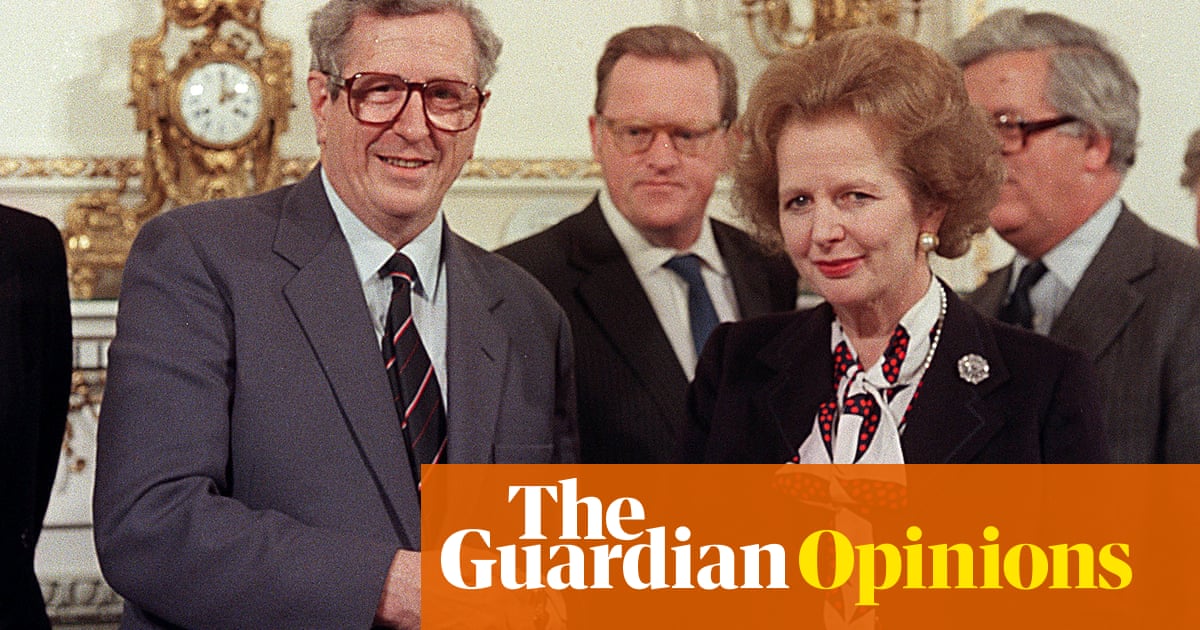
Seldom did a nickname feel so apt. Margaret Thatcher bent her foes – Tory sexists, trade union leaders, Argentine generals, Irish republicans, Soviet premiers – to her will. Armoured with a conviction she was right, she charged into one battle after another, slaying orthodoxy and precedents. What was this if not the work of an Iron Lady?
Thatcher unleashed a revolution in the 1980s that transformed Britain’s political economy, jolted Europe’s left-leaning consensus and emboldened her great ally Ronald Reagan. She widened the Great Man theory of history to include women, and fortified it. Epochal events bore her stamp.
But 10 years after her death on 8 April 2013, and 25 years on from the Good Friday agreement, these overlapping anniversaries illuminate a different Thatcher. A politician of steely resolve, yes, but who ended up a plaything of unintended effect.
Landmark policies that once clanged with certainty in Ireland in hindsight resemble leaves on a swirling breeze, their consequences scattered over unexpected resting places. Britain’s first female prime minister had conviction and clarity, but history spiralled around her legacy with twisting ironies. Today’s crop of ideological leaders should take note.
After her election in 1979 Thatcher did not seek a political solution to the Troubles. She sought to smother the Irish Republican Army’s violent campaign with security measures – more police, better intelligence, tougher prisons. She let 10 republican prisoners starve themselves to death in 1981 rather than cede political status to men she considered terrorists and criminals.
This made her a hate figure across Ireland, north and south, a fate she accepted. What she did not anticipate was Gerry Adams channelling this anger to steer Sinn Féin towards electoral politics.
Until then, Irish republicans had viewed politics as a trap, a path to compromise and sellout. But partly to spite Thatcher, they rallied behind a campaign to elect Bobby Sands and other hunger strikers to Westminster and the Dáil, setting a precedent that let Adams run other candidates and build a serious political party.
Sinn Féin’s “ballot box and Armalite” strategy had an expiry date. Eventually the movement would have to choose between IRA violence or electoral victories. Adams made sure it would be politics. Thatcher’s hawkishness opened the path.
In October 1984 the IRA exacted revenge for the dead hunger strikers by blowing up the Grand Hotel in Brighton, where Thatcher and her cabinet were staying during the Conservative party conference. Five died, dozens were injured. It was the most audacious attack on the British state since the 1605 Gunpowder Plot.
Thatcher escaped, and to her immense credit did not lash out with a security force crackdown. Instead, a year later, she made a bold act of statesmanship: with the taoiseach, Garret FitzGerald, she signed the Anglo-Irish agreement. It recognised that Catholics in Northern Ireland considered themselves Irish and gave Dublin, for the first time, a limited say in the region.
The treaty infuriated Northern unionists and some of Thatcher’s closest allies, such as Ian Gow. It was all the more startling given her own antipathy to Irish nationalism. She absorbed the denunciations in hope of achieving two goals: stopping Sinn Féin eating into the support of John Hume’s Social Democratic and Labour party; chivvying Dublin into improving border security and extraditing IRA suspects.
Her reward? Continued Sinn Féin ascent and negligible security improvements. Thatcher subsequently cooled on the agreement, her signature achievement in Ireland, but it was too late. Two parallel processes were unspooling that would change everything.
Adams, recognising the conflict was a futile stalemate, began secret talks via mediators with Irish and British government contacts. Irish and British officials, meanwhile, were getting to know and trust each other through operating the Anglo-Irish agreement. Eventually the two processes intersected and birthed the peace process. Thatcher was the accidental midwife.
Economic policy proved equally unpredictable. Nigel Lawson, the “golden boy” architect of her government’s success, ended up undermining her leadership.
After Thatcher resigned in 1990 the unforeseen consequences of her premiership gathered momentum. The IRA declared a ceasefire in 1994, paving the way for the Good Friday agreement in 1998. It was a leap of faith. Dublin got a greater role in Northern Ireland in return for dropping territorial claims. London promised to hold a referendum on Irish unity if a majority in Northern Ireland appeared to favour unification. Unionists and nationalists would share devolved powers in a Stormont assembly and executive.
The Good Friday agreement was imperfect and bequeathed political dysfunction, but in ending 30 years of conflict it was a thing of beauty. Thatcher’s courage and obduracy unwittingly helped to conjure it. She did not ask for, nor receive, plaudits.
For the retired prime minister there was an aggravating twist: the deal freed paramilitary prisoners, including Patrick Magee, the IRA operative who had planted the Brighton bomb that almost killed her and did kill some of her friends.
There was one final irony. Thatcher’s animus to Brussels outlived her and encouraged the Eurosceptic strain in the Conservatives that led to Brexit. That has destabilised Northern Ireland, paralysed power-sharing and emboldened advocates of a united Ireland.
“I am not a consensus politician. I’m a conviction politician,” Thatcher once said. More pithily, she also said: “You turn if you want to. The lady’s not for turning.”
But no amount of resolve could control the zigzag flow of events, contradictions and surprises that shape human affairs, including Thatcher’s legacy. This should be a lesson in humility for a polarised era. Hyper-partisans confuse zealotry with strength and certainty with consequence. They can be as righteous as they want. It guarantees nothing.
Rory Carroll is the Guardian’s Ireland correspondent and author of Killing Thatcher: the IRA, the Manhunt and the Long War on the Crown (which in the US is titled There Will Be Fire: Margaret Thatcher, the IRA and Two Minutes That Changed History)












